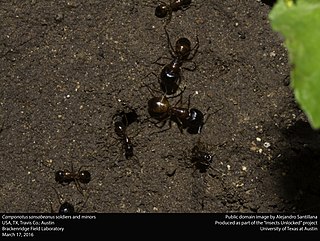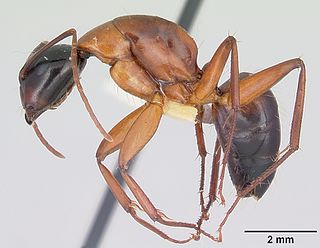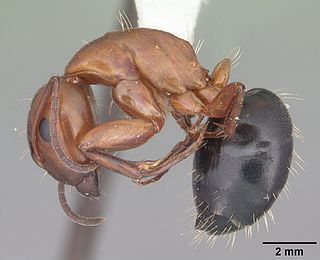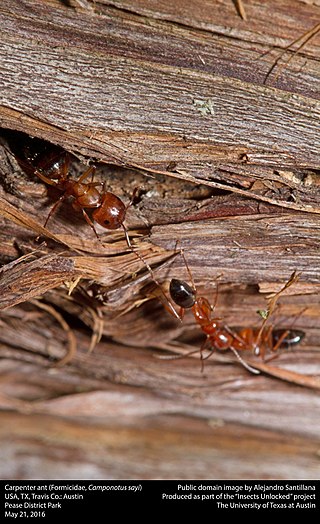
Camponotus sansabeanus is a species of carpenter ant native to the western United States, northern Mexico, Missouri, Arkansas, and Louisiana.

Camponotus fragilis is a species of carpenter ant endemic to California, Texas, Arizona, New Mexico, and western Mexico. It was first described by Theodore Pergande in 1893, subsequently synonymized, then finally revived by Roy Snelling in 2006.

Camponotus mina is a species of carpenter ant native to large parts of northern Mexico, California, Arizona, Texas, and New Mexico, and possibly Wyoming, South Dakota, and Minnesota.

Camponotus texanus is a species of carpenter ant native to Texas, Nuevo Leon, and possibly Arizona.

Camponotus vicinus is a species of carpenter ant widespread throughout western North America; it is found from Alaska, south to Mexico, and east to Texas and Manitoba. Unlike its wood-nesting relatives, C. vicinus is typically found nesting in the soil under stones and other objects.

Camponotus ocreatus is a species of carpenter ant native to northern Mexico and the southwestern United States.

Camponotus discolor is a species of carpenter ant native to the eastern United States, North Dakota, Nebraska, Texas, Kansas, Oklahoma, Nuevo Leon, Tamaulipas, and possibly California, Montana, Utah, and Colorado.

Camponotus decipiens is a species of carpenter ant native to the eastern United States, North Dakota, Nebraska, Kansas, Colorado, Texas, Tamaulipas, Nuevo Leon, San Luis Potosi, and possibly Utah, Arizona, Sonora, and California. The specific epithet of the scientific name, decipiens, comes from Latin "dēcipiens", meaning "decieving, cheating, or trapping".

Camponotus essigi is a species of carpenter ant native to the western United States, possibly Coahuila, and invasive in Trinidad and Tobago.

Camponotus subbarbatus. also known as the bearded carpenter ant, is a species of carpenter ant native to eastern North America.

Camponotus sayi is a species of carpenter ant native to the southwest United States, northern Mexico, and possibly North Dakota, Ontario, Mississippi, North Carolina, South Carolina, and Florida.

Camponotus clarithorax is a species of carpenter ant of the subgenus Camponotus native to California, Oregon, the Baja California Peninsula, and possibly the eastern United States. This species is found in Oregon, California, and Baja California.

Camponotus sericeiventris, the shimmering golden sugar ant, is a species of carpenter ant native to large parts of Central and South America. It is the only species in the subgenus Myrmepomis.

Camponotus yogi is a species of carpenter ant native to California and Baja California.

Camponotus bakeri is a species of carpenter ant native to California and Arizona.

Camponotus maccooki is a species of carpenter ant native to the western United States, British Columbia, Baja California, and possibly Colorado, Oklahoma, and Texas.

Camponotus maritimus is a species of carpenter ant native to California.

Camponotus microps is a species of carpenter ant native to Arizona, New Mexico, Sonora, Queretaro, and Guanajuato. This species was separated from the Camponotus festinatus complex in 2006 by Roy Snelling.

Camponotus pudorosus is a species of carpenter ant native to Arizona, New Mexico, Colorado, Mexico, and Guatemala. Originally described in 1925 by Carlo Emery and synonymized by W. W. Kempf in 1972, the species was revived in 2006 from the Camponotus festinatus complex by Roy Snelling.

Camponotus cuauhtemoc is a species of carpenter ant native to Texas and Chihuahua.




















